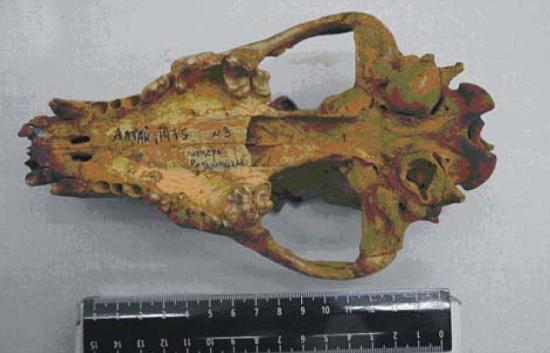俄国考古学家们最近发现了距今已经有33000年历史的狗头骨化石,这块保存得相当完好的化石是在西伯利亚的阿尔泰山的一个山洞中发现的。
据分析,这块头骨化石来自于最近一次冰河时期之前,它表现出一些和现代狗非常类似的生物学特征。

西伯利亚山上发现的这块33000年历史的狗头骨化石证实了过去的人类对这种动物的驯养(图)

考古学家发现虽然这块头骨的口鼻部大小和1000年前的格陵兰狗相似,但它的牙齿类似于欧洲野狼。(图)
该研究的论文发表在最近的《Plos one》杂志上,其中的一位作者Susan Crockford博士说道:“狼不会被轻易的驯服,将一只狼驯服成一只狗是一个漫长的自然选择过程。”
在冰河时期之前,人们狩猎动物食用后留下了大量骨头,这些会吸引起到狼。在这些被骨头吸引的狼群里,有的个体会表现出了一些像狗的特征,如好奇心和恐惧心。
在那个时期,这些狼通常比其它动物的口鼻和牙齿小,它们靠人类留下来的骨头生存,同时也帮助人类避开其它的食肉动物。
尽管如此,当冰河时期来临时,人类和这类动物的依赖关系似乎终止了。科学家们普遍认为这和那个时期的食物有限非常相关。
根据Crawford博士的研究,人类驯服这类动物成为现代狗用了大约两万年的时间。 (生物探索 Jun译)
生物探索推荐英文论文原文摘要:
A 33,000-Year-Old Incipient Dog from the Altai Mountains of Siberia: Evidence of the Earliest Domestication Disrupted by the Last Glacial Maximum
Background
Virtually all well-documented remains of early domestic dog (Canis familiaris) come from the late Glacial and early Holocene periods (ca. 14,000–9000 calendar years ago, cal BP), with few putative dogs found prior to the Last Glacial Maximum (LGM, ca. 26,500–19,000 cal BP). The dearth of pre-LGM dog-like canids and incomplete state of their preservation has until now prevented an understanding of the morphological features of transitional forms between wild wolves and domesticated dogs in temporal perspective.
Methodology/Principal Finding
We describe the well-preserved remains of a dog-like canid from the Razboinichya Cave (Altai Mountains of southern Siberia). Because of the extraordinary preservation of the material, including skull, mandibles (both sides) and teeth, it was possible to conduct a complete morphological description and comparison with representative examples of pre-LGM wild wolves, modern wolves, prehistoric domesticated dogs, and early dog-like canids, using morphological criteria to distinguish between wolves and dogs. It was found that the Razboinichya Cave individual is most similar to fully domesticated dogs from Greenland (about 1000 years old), and unlike ancient and modern wolves, and putative dogs from Eliseevichi I site in central Russia. Direct AMS radiocarbon dating of the skull and mandible of the Razboinichya canid conducted in three independent laboratories resulted in highly compatible ages, with average value of ca. 33,000 cal BP.
Conclusions/Significance
The Razboinichya Cave specimen appears to be an incipient dog that did not give rise to late Glacial – early Holocene lineages and probably represents wolf domestication disrupted by the climatic and cultural changes associated with the LGM. The two earliest incipient dogs from Western Europe (Goyet, Belguim) and Siberia (Razboinichya), separated by thousands of kilometers, show that dog domestication was multiregional, and thus had no single place of origin (as some DNA data have suggested) and subsequent spread.
生物探索推荐:







